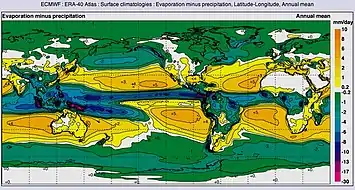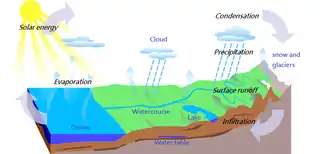Effects of climate change on the water cycle
The effects of climate change on the water cycle has important knock-on effects on the availability of freshwater resources, as well as other water reservoirs such as oceans, ice sheets, atmosphere and land surface. The water cycle is essential to life on earth and plays a large role in the global climate and the ocean circulation. The warming of the earth is expected to cause changes in the water cycle for various reasons.[1] A warmer atmosphere can contain more water vapor which has effects on evaporation and rainfall. Oceans play a large role as well, since they absorb 93% of the increase in heat since 1971.[2] This has effects on the water cycle and on human society, since the ocean warming directly leads to sea level rise.[1]

Causes of intensifying water cycle
The increased amount of greenhouse gases leads to a warmer atmosphere.[1] The saturation vapor pressure of air increases with temperature, which means that warmer air can contain more water vapor. Because the air can contain more moisture, the evaporation is enhanced. As a consequence, the increased amount of water in the atmosphere leads to more intense rainfall.[3]
This relation between temperature and saturation vapor pressure is described in the Clausius-Clapeyron equation, which states that saturation pressure should increase 7% when temperature rises with 1°C.[4] This is visible in measurements of the tropospheric water vapor, which are provided by satellites, radiosondes and surface stations. The IPCC AR5 concludes that tropospheric water vapor has increased by 3.5% the recent 40 years, which is consistent with the observed temperature increase of 0.5 °C.[1] It is therefore expected that the water cycle is intensifying, but more evidence is needed to say so.
Impacts on the water cycle

Fresh water covers only 0.8% of the Earth's surface, but contains up to 6% of all life on the planet.[5] However, the impacts climate change deal to its ecosystems are often overlooked. Very few studies showcase the potential results of climate change on large-scale ecosystems which are reliant on freshwater, such as river ecosystems, lake ecosystems, desert ecosystems, etc. However, a comprehensive study published in 2009 delves into the effects to be felt by lotic (flowing) and lentic (still) freshwater ecosystems in the American Northeast. According to the study, persistent rainfall, typically felt year round, will begin to diminish and rates of evaporation will increase, resulting in drier summers and more sporadic periods of precipitation throughout the year.[6] Additionally, a decrease in snowfall is expected, which leads to less runoff in the spring when snow thaws and enters the watershed, resulting in lower-flowing fresh water rivers.[6] This decrease in snowfall also leads to increased runoff during winter months, as rainfall cannot permeate the frozen ground usually covered by water-absorbing snow.[6] These effects on the water cycle will wreak havoc for indigenous species residing in fresh water lakes and streams.
Impacts on freshwater resources
The freshwater resources that humans rely on are highly sensitive to variations in weather and climate.[7] The sustained alteration of climate directly impacts the hydrosphere and hydrologic cycle changing how humans interact with water across the globe In 2007, the IPCC reported with high confidence that climate change has a net negative impact on water resources and freshwater ecosystems in all regions.[8] The IPCC also found with very high confidence that arid and semi-arid areas are particularly exposed to freshwater impacts.[8] In addition, the IPCC forecasts increased uncertainty in the amount and frequency of precipitation from the year 2000 to 2100.[9]
As the climate warms, it changes the nature of global rainfall, evaporation, snow, stream flow and other factors that affect water supply and quality. Specific impacts include:
- Warmer water temperatures affect water quality and accelerate water pollution.[10]
- Sea level rise is projected to increase salt-water intrusion into groundwater in some regions. This reduces the amount of freshwater available for drinking and farming.[10][11]
- In some areas, shrinking glaciers and snow deposits threaten the water supply.[12] Areas that depend on melted water runoff will likely see that runoff depleted, with less flow in the late summer and spring peaks occurring earlier.[10] This can affect the ability to irrigate crops. (This situation is particularly acute for irrigation in South America,[13] for irrigation and drinking supplies in Central Asia, and for hydropower in Norway, the Alps, and the Pacific Northwest of North America.)
- Increased extreme weather means more water falls on hardened ground unable to absorb it, leading to flash floods instead of a replenishment of soil moisture or groundwater levels.[14]
- Increased evaporation will reduce the effectiveness of reservoirs.
- Increased precipitation can lead to changes in water-borne and vector-borne diseases.[15]
Droughts
Climate change affects multiple factors associated with droughts, such as how much rain falls and how fast the rain evaporates again. Warming over land drives an increase in atmospheric evaporative demand which will increase the severity and frequency of droughts around much of the world.[16][17] Due to limitations on how much data is available about drought in the past, it is often impossible to confidently attribute droughts to human-induced climate change. Some areas however, such as the Mediterranean and California, already show a clear human signature.[18] Their impacts are aggravated because of increased water demand, population growth, urban expansion, and environmental protection efforts in many areas.[19]
In 2019 the Intergovernmental Panel on Climate Change issued a Special Report on Climate Change and Land. The main statements of the report include:[20][21] In the years 1960 – 2013 the area of drylands in drought, increased by 1% per year. In the year 2015 around 500 million people lived in areas that was impacted by desertification in the years 1980s – 2000s. People who live in the areas affected by land degradation and desertification are "increasingly negatively affected by climate change".References
- IPCC (2013). Climate Change 2013: The Physical Science Basis. Contribution of Working Group I to the Fifth Assessment Report of the Intergovernmental Panel on Climate Change. [Stocker, T.F., D. Qin, G.-K. Plattner, M. Tignor, S.K. Allen, J. Boschung, A. Nauels, Y. Xia, V. Bex and P.M. Midgley (eds.)]. Cambridge University Press.
- Durack, Paul (2015-03-01). "Ocean Salinity and the Global Water Cycle". Oceanography. 28 (1): 20–31. doi:10.5670/oceanog.2015.03. ISSN 1042-8275.
- Trenberth, Kevin E.; Smith, Lesley; Qian, Taotao; Dai, Aiguo; Fasullo, John (2007-08-01). "Estimates of the Global Water Budget and Its Annual Cycle Using Observational and Model Data". Journal of Hydrometeorology. 8 (4): 758–769. Bibcode:2007JHyMe...8..758T. doi:10.1175/jhm600.1. ISSN 1525-7541.
- Brown, Oliver L. I. (August 1951). "The Clausius-Clapeyron equation". Journal of Chemical Education. 28 (8): 428. Bibcode:1951JChEd..28..428B. doi:10.1021/ed028p428. ISSN 0021-9584.
- Woodward, Guy; Perkins, Daniel M.; Brown, Lee E. (12 July 2010). "Climate change and freshwater ecosystems: impacts across multiple levels of organization". Philosophical Transactions of the Royal Society B: Biological Sciences. 365 (1549): 2093–2106. doi:10.1098/rstb.2010.0055. PMC 2880135. PMID 20513717.
- Brooks, Robert T. (6 January 2009). "Potential impacts of global climate change on the hydrology and ecology of ephemeral freshwater systems of the forests of the northeastern United States". Climatic Change. 95 (3–4): 469–483. Bibcode:2009ClCh...95..469B. doi:10.1007/s10584-008-9531-9. S2CID 154713741.
- Heidari, Hadi; Arabi, Mazdak; Warziniack, Travis; Kao, Shih-Chieh (2020). "Assessing Shifts in Regional Hydroclimatic Conditions of U.S. River Basins in Response to Climate Change over the 21st Century". Earth's Future. 8 (10): e2020EF001657. Bibcode:2020EaFut...801657H. doi:10.1029/2020EF001657. ISSN 2328-4277.
- Kundzewicz Z.W.; et al. (2007). "Freshwater resources and their management. In: Climate Change 2007: Impacts, Adaptation and Vulnerability. Contribution of Working Group II to the Fourth Assessment Report of the Intergovernmental Panel on Climate Change M.L. Parry et al. (eds.)". Cambridge University Press, Cambridge, U.K., and New York, N.Y., U.S.A. pp. 173–210. Retrieved 20 May 2009.
- "Glossary – Global Warming of 1.5 °C". Retrieved 20 April 2021.
- "Dr. Kathleen Miller's Research: Climate Change Impacts on Water". Archived from the original on 31 October 2015. Retrieved 10 November 2009.
- "EPA : Global Warming : Resource Center : Publications : Sea Level Rise : Sea Level Rise Reports". Archived from the original on 10 July 2009.
- Kazakhstan: glaciers and geopolitics Archived 6 January 2018 at the Wayback Machine Stephan Harrison openDemocracy May 2005
- News, BBC (9 October 2003). "Melting glaciers threaten Peru". BBC News.
- "Climate Change and Mental Health". Psychiatry.org. Retrieved 26 February 2018.
- Rahman, A. (2008). "Climate Change and its Impact on health in Bangladesh" (PDF). Regional Health Forum. 12: 16–26.
- IPCC AR6 WG1 Ch8 2021, p. 8-6, line 37
- Cook, Benjamin I.; Mankin, Justin S.; Anchukaitis, Kevin J. (12 May 2018). "Climate Change and Drought: From Past to Future". Current Climate Change Reports. 4 (2): 164–179. doi:10.1007/s40641-018-0093-2. ISSN 2198-6061. S2CID 53624756.
- Mukherjee, Sourav; Mishra, Ashok; Trenberth, Kevin E. (23 April 2018). "Climate Change and Drought: a Perspective on Drought Indices". Current Climate Change Reports. 4 (2): 145–163. doi:10.1007/s40641-018-0098-x. ISSN 2198-6061. S2CID 134811844.
- Mishra, A. K.; Singh, V. P. (2011). "Drought modeling – A review". Journal of Hydrology. 403 (1–2): 157–175. Bibcode:2011JHyd..403..157M. doi:10.1016/j.jhydrol.2011.03.049.
- IPCC SRCCL 2019, pp. 7, 8
- IPCC SRCCL Summary for Policymakers 2019, p. 7,8